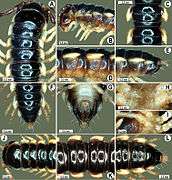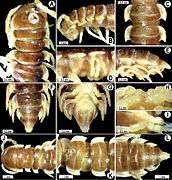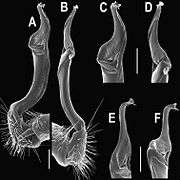Orthomorpha coarctata
Orthomorpha coarctata (alternately known as Asiomorpha coarctata) is a widely introduced species of Polydesmidan millipede of the family Paradoxosomatidae. It is presumed native to Southeast Asia but due to transport by humans occurs in tropical and sub-tropical areas throughout the world, including the Hawaiian Islands, the West Indies and Gulf Coast of North America.[1][2] Males range from 14.5–20.5 mm in length and 1.5 to 2.7 mm wide while females are somewhat larger ranging from 16.5–27.5 mm long, and 1.6–3.2 mm wide.[3] O. coarctata can be distinguished from Oxidus gracilis, another widely introduced Asian millipede, by having proportionally longer and pointier paranota (lateral keels) on mid-body segments and longer gonopods (male reproductive appendages).[4]
O. coarctata is unique within the genus Orthomorpha in that the gonopods have a single, simple tip, while other species have two or three lobes. This distinction has led some authors to place O. coarctata in a separate, monotypic genus, Asiomorpha.[1][3]
| Anatomy of an individual collected in Thailand |
| Anatomy of male (A-I) and female (J-L) |
|
References
- 1 2 Hoffman, R. L. (1999). "Checklist of the millipeds of North and Middle America". Virginia Museum of Natural History Special Publications. 8: 1–553. p. 415
- ↑ McCormack, Gerald (2007). "Asiomorpha coarctata, Long-flange Millipede". Cook Islands Biodiversity Database, Version 2007.2. Cook Islands Natural Heritage Trust, Rarotonga. Retrieved 20 May 2014.
- 1 2 Likhitrakarn, Natdanai; Golovatch, Sergei; Panha, Somsak (2011). "Revision of the Southeast Asian millipede genus Orthomorpha Bollman, 1893, with the proposal of a new genus (Diplopoda, Polydesmida, Paradoxosomatidae)". ZooKeys. 131 (131): 1–161. doi:10.3897/zookeys.131.1921. PMC 3208436
 . PMID 22140329.
. PMID 22140329. - ↑ McCormack, Gerald (2007). "Oxidus gracilis, Short-flange Millipede". Cook Islands Biodiversity Database, Version 2007.2. Cook Islands Natural Heritage Trust, Rarotonga. Retrieved 20 May 2014.
External links
.jpg)
 . PMID 22140329.
. PMID 22140329. Media related to Orthomorpha coarctata at Wikimedia Commons
Media related to Orthomorpha coarctata at Wikimedia Commons

